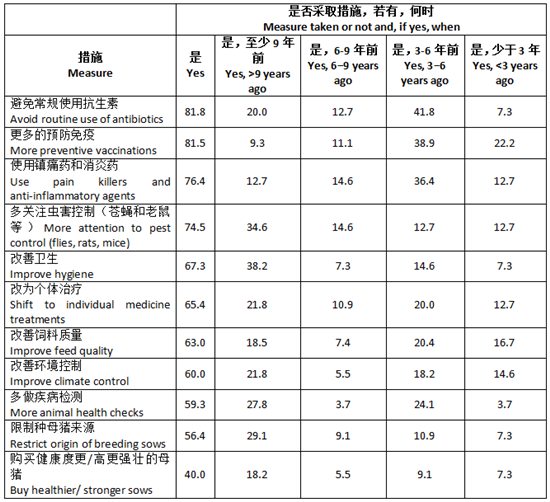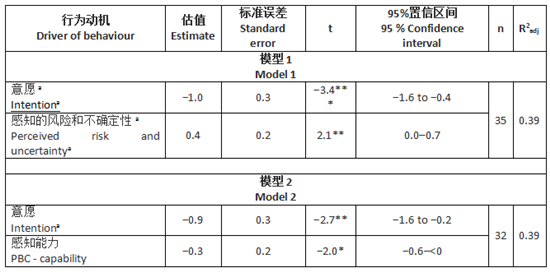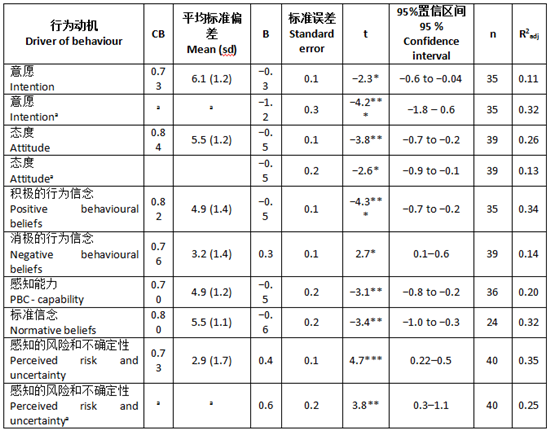译者的话
抗生素(不包括疫苗)在国内规模化养殖场的生产成本中占比约为2.5-5%,不是很高,但头均绝对用量相对于欧美养殖业还有很大的降幅空间。荷兰汇总性数据显示:抗生素使用的减少不会对农场的技术或经济效益造成负面影响,对为改善动物健康而采取的措施进行了后续调查,这些措施使减少抗生素的使用成为一种可能。随着我国经济水平的进一步提升,养殖业的减抗、禁抗乃至无抗从由部分企业自发的行为逐渐演变为政府强制性的法规。无论是养殖业主还是养殖从业者,抗生素用量的降低不仅仅是养殖成本的关注,更多的是对美好生活的一种态度。打开南风窗,请赏《荷兰养猪场抗生素使用与盈利情况对比》。
荷兰养猪场抗生素使用与盈利情况对比(下)
Antibiotics Use Versus Profitability on Sow Farms in the Netherlands-Part 3
接上文...
3.结果Results
3.3.导致抗生素使用变化的行为因素
Behavioural factors attributing to antibiotics use change
在拜访的79位母猪养殖户中,有55位参与了调查。表3显示了受访母猪养殖户为改善其动物健康或其农场健康状况所采取的措施汇总。这些措施主要侧重于动物健康管理,如改善生物安全、使用消炎药或预防接种。大多数农场主在采访时表示,他们实施这些措施还不足9年(正是9年前荷兰政府提出了减少兽用抗生素使用的目标:在2009年使用量的基础上,2011年减少20%,2015年减少50%,2013年减少70%)。这些措施实施后,大多数农场主继续保持了下来。
Of the 79 sow farmers approached,55 participated in the survey.Table 3 shows a summary of the measures interviewed sow farmers took to improve the health of their animals or the health status of their farms.Measures focused mainly on animal health management,such as improving biosecurity,use of anti-inflammatory agents or preventive vaccinations.The majority of the famers indicated in the interviews that they implemented the measures less than nine years ago(the moment that the Dutch government provided objectives for a reduction in veterinary antibiotics use:20%in 2011,50%in 2013 and 70%in 2015 relative to the use in 2009).Once implemented,most farmers continued taking these measures.
表3:在2004-2016年间,至少40%以上的受访荷兰母猪养殖户(n=55)在减少抗生素使用的同时所采取的措施,以最大程度的降低对技术和生产性能的影响(占养殖户比例)。
Table 3.Measures taken by 40%or more of the interviewed Dutch sow farmers(n=55)for time period 2004-2016 to minimise the impact on technical and performance when reducing antibiotic use(%of farmers).

对受访的母猪养殖户来说,兽医似乎是最重要的信息来源,其次是饲料供应商(平均分为6.4分和5.4分)。受访母猪养殖户对兽医的信任度最高,其次是饲料供应商和客户(平均得分分别为6.3、5.0和5.0)。个人咨询是获取信息的首选方式(平均6.2分),其次是学习小组(5.3分)、互联网(5.1分)和研究报告(5.1分)。
The veterinarian appeared to be the most important source of information to the interviewed sow farmers,followed by the feed supplier(mean score 6.4 and 5.4 respectively).The interviewed sow farmers also complied the most to the veterinarian,followed by the feed supplier and the customer(mean score and 6.3,5.0 and 5.0 respectively).Individual advice is the preferred way to obtain information(mean score 6.2),followed by study groups(5.3),internet(5.1)and research reports(5.1).
用多变量回归分析发现抗生素使用的最佳预测指标(用2014年到2016年间抗生素日使用剂量的平均数的对数表示)显示了两个替代模型(表4),在模型1中,保持抗生素的使用量处于或者低于目标值的意愿以及感知的风险和不确定性是抗生素使用的最重要的预测因子(R2adj=0.39,n=35)。在模型2中,保持抗生素的使用量处于或者低于目标值的意愿和感知能力似乎是最重要的预测因子(R2adj=0.39,n=32)。
Multivariable regression analyses to find the best predictors of antibiotics use(expressed as the logarithm of the average number of daily doses per animal year from 2014 to 2016)revealed two alternative models(Table 4).In model 1 the intention,to keep or get the antibiotics use under the target value,and perceived risk and uncertainty were the most important predictors of antibiotics use(R2adj=0.39,n=35).In the alternative model 2,the intention and the perceived capability to keep or get the antibiotics use under the target value seemed to be the most important predictors(R2adj=0.39,n=32).
表4:基于多变量线性回归分析的荷兰母猪场抗生素使用预测因子(2014年到2016年间抗生素日使用剂量的平均数的对数)。
Table 4.Predictors of antibiotics use(logarithm of average number of daily doses per animal year from 2014-2016(NDD))based on multivariable linear regression analyses for Dutch sow farms.

*p<0.10.
**p<0.05.
***p<0.01.
a由于构念不是正态分布,因此转化为三分位数。
Transformation into 3 tertiles because construct was not a normal distribution.
单因素回归分析表明,使用抗生素较少的母猪养殖户与使用抗生素较多的母猪养殖户相比(详见表5):
The univariate regression analyses indicated that sow farmers who use less antibiotics compared to sow farmers that use more antibiotics(Table 5):
1、保持抗生素的使用量处于或者低于目标值的意愿比较高,并且有信心能做到。
Had a higher intention to get or keep the use of antibiotics under the target value and are more positive about it;
2、对于“如果减少抗生素的使用就会让农场生产业绩更差”这一认识的认同度不高(单独项目的反面行为信念);
Thought to a lesser extent that farm results will get worse if they reduce the use of antibiotics(separate item of negative behavioural beliefs);
3、认为减少抗生素的使用可以增加工作的愉悦度,并且对猪群健康、动物福利和人类健康更好(单独项目的正面行为信念);
Thought that less use of antibiotics increases work pleasure and is good for animal health,animal welfare and human health(separate items of positive behavioural beliefs);
4、对于“其他养殖户、客户、合伙人和邻居期望他们减少抗生素的使用”这一认识的认同度很高(单独项目的标准信念);
Thought to a higher extent that colleague-pig farmers,customers,the government,the partner and the neighbour expect them to reduce the use of antibiotics(separate items of normative beliefs);
5、认为他们有足够的时间和知识可以把抗生素的使用量保持在目标以下或者达标(单独项目的感知行为控制能力);
Perceived to have enough knowledge and time to keep or get antibiotics use under the target value(separate items of perceived behavioural control–capability);
6、感知到的风险和不确定性较少。
Perceived less risk and uncertainty.
表5:估计2014-2016年荷兰养猪户的态度、意愿和感知与NDD(每动物年的日剂量数)对数之间关系的单变量回归模型(CB=克隆巴赫系数Cronbachs Alpha)。
Table 5.Univariate regression models estimating the relationship between Dutch pig farmers’attitudes,intention and perceptions and the logarithmic number of NDD(Number of Daily Doses per animal year)from 2014-2016(CB=Cronbachs Alpha).

*p<0.05.
**p<0.01.
***p<0.001.
a由于构念不是正态分布,因此转化为三分位数。
Transformation into tertiles because construct was not a normal distribution.
4.讨论和总结Discussion and conclusions
总体而言,2004年至2016年,荷兰农场抗生素的使用对不同经济指标的不利影响有限。鉴于本研究中使用的因变量的层次结构,当经济指标处于较高的综合水平时(从动保成本到总成本),这种影响似乎就会消失。这可能是由于每个增加的层次中解释变量的其他可变因素的比例增加,以及抗生素使用的影响可能不会大于每个增加的步骤中增加的变异或随机误差。
In general,the adverse effect of antibiotics use of Dutch farms on different indicators of economic performance during 2004 until 2016 was limited.Given the hierarchical structure of the dependent variables used in this study,the effect seems to disappear when economic performance indicators are at a higher aggregated level(from animal health costs to total costs).This may have occurred due to the increased share of other volatile factors explaining the variable at each added hierarchical step and the fact that the effect of antibiotics use may not be larger than the added variation or random error at each added step.
FADN数据集包含技术和财务变量。但是,没有记录有关一般健康状况或更具体的受感染动物数量的数据。也就是说农场主可能会在猪群到场之后使用更多的抗生素来防止猪群疾病在场内传播。在这种情况下,使用更多的抗生素在经济上是可行的。然而,管理不善的情况下会发生大范围的感染,而更多使用抗生素可以用以弥补猪群管理不善带来的后果(Ge et al.,2014)。因此,通过衡量抗生素使用的影响,该模型可能在一定程度上也衡量了猪群健康管理不善对农场生产业绩的影响。甚至,在样本的最后几年,农场主在使用较少的抗生素的情况下猪群管理也做的越来越高效和熟练。如果农场主的这种熟练程度提高了,也就可以解释在我们的模型中抗生素的使用对农场生产业绩的影响是有限的。
The FADN dataset contained both technical and financial variables.However,data on the health status in general or more specific the number of infected animals is not registered.A farmer may,for instance,use more antibiotics to prevent the spread of animal disease on the farm after introduction.In that instance,it may be economically viable to use more antibiotics.Nevertheless,widespread infections may be more prevalent in the cases of poor animal management.An increase in antibiotics use may be used to compensate for poor animal management(Ge et al.,2014).Therefore,by measuring the effect of antibiotics use,the models may have partly measured the effect of poor animal health management on farm performance.Even more,it may have been the case that,in the later years of the sample,farmers became increasingly proficient in managing livestock with less antibiotics use.If this proficiency of the farmers increased,it may explain the limited influence of antibiotics use on farm performance in our models.
通过对整个样本的分析,可以隐含地假设抗生素的使用对所有样本的影响是相同的。然而,在不同的子样本中,使用抗生素的效果可能并不相同。荷兰政府在2008年主动减少了荷兰畜牧业的抗生素使用(Bondt和Kortstee,2016)。这一做法可能已经改变了源数据生成过程。因此,将样本分为2004-2008年和2009–2016年两个子样本。2004-2008年间,就每头母猪的总成本而已,抗生素的使用效果是不同的(显著正系数),而每头母猪动保成本中NDD的系数仍然显著,但正估计值较低。对于总成本模型的不稳健性,一种可能的解释是,2009年以后,抗生素只在必要时使用,而2009年以前,抗生素的使用更自由(但无效果),增加了总成本。我们(有限的)调查数据似乎证实了这一点。受访农场主采用了各种相对简单、负担得起的措施,比如更加注重卫生、使用止痛药和消炎药或进行更多的预防性接种,以改善动物健康,使减少抗生素使用成为可能。大多数受访农场主实施这些措施的时间不到9年。而9年前,荷兰政府为减少兽医抗生素的使用提出了明确的目标:与2009年相比,2011年减少20%,2013年减少50%,2015年减少70%。显然,这一明确的政策有助于刺激农场主开始采取措施。
By analysing the entire sample,it was implicitly assumed that the effect of antibiotics use would be the same across this sample.However,it may be the case that the effect of antibiotics use is not the same across subsamples.The Dutch government took the initiative to decrease antibiotics use in the Dutch livestock sector in 2008(Bondt and Kortstee,2016).This disruption may have changed the underlying data generating process.Therefore,the sample was divided into subsamples of 2004–2008 and 2009−2016.The effect of antibiotics use is different in the case of the total costs per sow in 2004–2008(significant positive coefficient),while the coefficient of NDD in animal health costs per sow remains significant,but the positive estimator is lower.A possible explanation for this non-robustness of the total cost model may be that after 2009 antibiotics were only used when it was necessary,while it was more freely(inefficiently)used before 2009,adding to the total costs.Our(limited amount of)survey data seem to confirm this.The interviewed farmers used a variety of relatively easy and affordable measures,such as more attention to hygiene,use of pain killers and anti-inflammatory agents or applied more preventive vaccinations to improve animal health and make the reduction in antibiotic use feasible.The majority of the interviewed famers implemented these measures less than nine years ago.From that moment the Dutch government provided clear objectives for a reduction in veterinary antibiotics use:−20%in 2011,−50%in 2013 and−70%in 2015 relative to the use in 2009.Apparently,this clear policy was helpful to stimulate farmers to start taking measures.
因为数据是在自愿的基础上提供的,因此FADN的数据集的代表性可能有限。这可能会导致自我选择偏差,因为生产成绩好的农场会报告他们的数据,而成绩不好的农场则不会提供。本研究将我们样本中的抗生素使用情况与Stichting Diergeneesmiddelen Autoriteit(2018)体系中所有的荷兰母猪场的抗生素使用情况进行了比较。结果表明,2009年母猪平均NDD为27.48,2016年为7.25(−73.6%)。据Stichting Diergeneesmiddelen Autoriteit(2018)报道,养猪生产中抗生素的使用下降了57%,包括母猪场和肥育猪场。在我们的样本中,抗生素使用的减少幅度比总体的要大。可能是因为我们的样本中存在一些自我选择偏差。
The representability of the FADN dataset could be limited as the data was provided on a voluntary basis.This could have led to self-selection bias,in which well-performing farms would report their data,while less performing farms would not.This study has compared the antibiotics use in our sample to the antibiotics use of the total population of Dutch sow farms as provided by Stichting Diergeneesmiddelen Autoriteit(2018).Our results indicate that the mean NDD of sows was 27.48 in 2009,while it was 7.25 in 2016(−73.6%).Stichting Diergeneesmiddelen Autoriteit(2018)reported a decrease in antibiotics use in pig production of 57%.In the case of pig production,this includes both sow farms and fattening pig farms.The decreases in antibiotics use are larger in our sample than in the general population.It may be the case that there is some self-selection bias in our sample.
总体而言,本文给出的结果似乎与其他研究抗生素使用对生产成绩影响的结果一致(Emborg et al.,2001;McDowell et al.,2008)。然而,这些作者主要关注技术变量而不是经济变量。因此,抗生素的使用对经济效益的影响需要更多的研究。下一个挑战可能是说服农场主和兽医,经济效益和抗生素使用之间的有限关系,因为有一部分农场主和兽医仍然认为抗生素对维持农场的经济效益来说是一种具有成本效益或有利可图的措施(Coyne et al.,2014;Moreno,2014;Speksnijder et al.,2015a)。我们的结果表明,在不影响经济效益或技术绩效的情况下,这些减少抗生素使用的努力是相当成功的,这与其他文献的结论是一致的(Rojo-Gimeno et al.,2016;Collineau et al.,2017;Postma et al.,2017)。
Overall,the results presented here seem to agree with the results of others investigating the effect of antibiotics use on productivity(Emborg et al.,2001;McDowell et al.,2008).However,these authors primarily focused on technical variables rather than economic variables.Therefore,more research is needed on the effects of antibiotics use on the economic performance.The next challenge may be to convince farmers and veterinarians of the limited relationship between economic performance and antibiotics use as a proportion of farmers and veterinarians still see antibiotics as a cost-effective or profitable measure to uphold economic performance of the farm(Coyne et al.,2014;Moreno,2014;Speksnijder et al.,2015a).In accordance with other literature,our results show that these efforts to decrease antibiotics use can be quite successful without compromising on the economic or technical performance(Rojo-Gimeno et al.,2016;Collineau et al.,2017;Postma et al.,2017).
4.讨论和总结Discussion and conclusions
在后续调查中,使用抗生素较多的母猪养殖户更担心低抗生素使用量会损害他们的生产成绩果,感知到更多的风险和不确定性,而对于他们自身是否有足够的知识和时间则没有怎么考虑过。这些结果表明,向这些农场主提供有关减少抗生素使用的管理措施的知识和信息可能会有所帮助。我们的研究结果显示,受访的母猪养殖户认为兽医是最重要的信息来源,其次是饲料供应商。受访母猪养殖户对兽医的服从程度最高,其次是饲料供应商和客户。因此,若有兽医甚至是饲料供应商的持续参与(最好是能提供个性化的建议)将是很有帮助的,因为结果表明,所采访的母猪农场主表示,个性化的建议是首选的获得信息和知识的途径。De Lauwere和Bokma(2019)在肉鸡养殖户中发现了类似的结果。Jones等人(2015)也提到了兽医在抗生素使用方面的重要性。Garforth等人(2013)非常重视权威信息的获取,大多数人将兽医视为解读地方背景下国家机构一般性建议的主要来源。Speksnijder等人(2015)强调了兽医的态度对抗生素使用和减少的重要性。他们发现,特别有经验丰富的兽医可以接受有关兽医过度使用抗生素可能带来的风险的教育,而年轻的兽医可能需要额外的支持才能独立于农场主和重要他人的建议而自己独立行事。
In the follow-up survey,sow farmers who used more antibiotics were more concerned that low antibiotics use compromises their farm results,perceived more risk and uncertainty,and thought to a lesser extent that they have enough knowledge and time.These results indicate that providing these farmers with knowledge and information on management practices to reduce the use of antibiotics may be helpful.The results of our study revealed that the interviewed sow farmers perceived the veterinarian to be the most important source of information,followed by the feed supplier.The interviewed sow farmers also complied the most to the veterinarian,followed by the feed supplier and the customer.For that reason,it would be useful to focus on continuous involvement of the veterinarian and possibly the feed supplier in providing knowledge about reduction of antibiotics use to sow farmers,preferably by means of individual advice,as the results showed that individual advice was the preferred way to gather knowledge for the interviewed sow farmers.Comparable results were found for broiler farmers by De Lauwere and Bokma(2019).The importance of the veterinarian with regard to the use of antibiotics is also mentioned by Jones et al.(2015).Garforth et al.(2013)placed great importance on access to authoritative information with most seeing veterinarians as the prime source to interpret generic advice from national bodies in the local context.Speksnijder et al.(2015)emphasized the importance of attitudes of veterinarians towards antibiotic use and reduction opportunities.They found that especially experienced veterinarians could be educated about possible risks related to veterinary overuse of antibiotics,while younger veterinarians might require additional support to act independently from farmers’and significant others.
Garforth et al.(2013)认为,影响农场主决定是否要实施特定疾病风险措施的主要因素有:对疾病风险的态度和认知;对具体措施及其效力的态度;对疾病或措施的以往经验;以及信息和建议的可信度。在我们的研究中,抗生素使用较少的受访母猪养殖户对能保持抗生素使用量处于或低于目标持积极态度,他们感知的风险和不确定性更小。在乳腺炎的预防(Scherpenzeel et al.,2017)和治疗(Swinkels et al.,2015)方面,不确定性也是抗生素使用的驱动因素。Trujillo-Barrera等人(2016)发现,感知风险似乎是采取可持续实践的障碍,而风险容忍度似乎是经济回报和采用可持续实践之间关系的积极的调和剂。
According to Garforth et al.(2013),the main factors that influenced livestock farmers’decision on whether or not to implement a specific disease risk measure are:attitudes to,and perceptions of,disease risk;attitudes towards the specific measure and its efficacy;previous experience of a disease or of the measure;and the credibility of information and advice.In our study,interviewed sow farmers with lower use of antibiotics had a more positive attitude towards keeping or getting antibiotics use under the target value,and perceived less risk and uncertainty.Uncertainty as driver for antibiotics use is mentioned as well in dairy farming with regard to the prevention(Scherpenzeel et al.,2017)and treatment of mastitis(Swinkels et al.,2015).Trujillo-Barrera et al.(2016)found that perceived risk appeared to be a barrier to the adoption of sustainable practices,while risk tolerance appeared to be a positive moderator of the relationship between economic rewards and adoption.
被调查的母猪养殖户在消极行为信念方面得分较低,在积极行为信念方面得分较高,他们认为自己更有能力将抗生素的使用保持在目标值以下。De Lauwere和Bokma(2019)在肉鸡养殖户中发现了类似的结果。态度、信念和自我效能是采取动物健康相关的措施的更常见的驱动因素。例如,Jansen et al.(2010)关于乳房炎控制,Sok et al.(2015、2016)关于自愿对抗蓝舌病的疫苗接种计划,Marier et al.(2016)关于沙门氏菌的控制和Ritter et al.(2017)关于动物疾病的控制方案。
The surveyed sow farmers also had lower scores for negative and higher scores for positive behavioural beliefs and perceived themselves more capable of keeping or getting the use of antibiotics under the target value.Comparable results were found for broiler farmers by De Lauwere and Bokma(2019).Attitude,beliefs and self-efficacy are more often mentioned as drivers to take animal health related measures,for example by Jansen et al.(2010)with regard to mastitis control,Sok et al.(2015,2016)with regard to a voluntary vaccination programme against Bluetongue,Marier et al.(2016)with regard to Salmonella control and Ritter et al.(2017)with regard to animal disease control programmes.
研究表明,在不影响经济效益和技术绩效的情况也可以很成功地减少抗生素的使用,而且考虑农场主的态度、认知和偏好可以帮助更好地理解他们的决策和制定客制化的干预措施。
The study showed that decrease in antibiotics use can be quite successful without compromising on the economic or technical performance,and moreover taking into account farmers’attitudes,perceptions and preferences can be helpful to get a better understanding of farmers’decision making and is useful for the design of tailor-made interventions.


